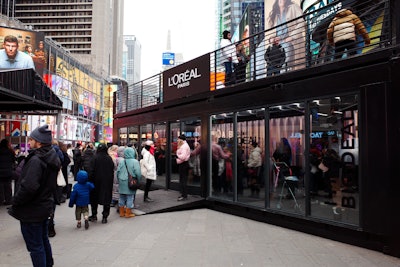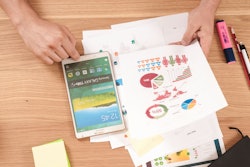
Temporary pop-up activations have grown in popularity over the past several years, offering brands a unique opportunity to engage with customers and create brand awareness. Usually set up in high-traffic areas, these activations often come in the form of mobile trucks, vacant spaces, or custom builds designed to attract new customers and strengthen loyalty among existing ones.
But how do you measure the success of an activation like this? BizBash asked event profs to share their insights into tracking the performance of a pop-up—specifically metrics not related to sales or revenue.
Like any event, clients task event producers and agencies with achieving specific goals via the pop-up experience. That could include short-term goals such as launching a product or testing a new market, or longer-term ones such as growing a customer base.
Keep reading to find out how event profs (and their clients) consider it a job well done...
 Strategically positioned at the center of activity along the Croisette at Cannes, the WSJ Bistro served close to 800 attendees throughout the course of the week.Photo: Courtesy of Dow Jones
Strategically positioned at the center of activity along the Croisette at Cannes, the WSJ Bistro served close to 800 attendees throughout the course of the week.Photo: Courtesy of Dow Jones
Reaching a targeted audience
"When we think about experiential marketing pop-ups, for us, it's not always about maximizing reach and driving social media engagement. Sometimes, it's about curating really dynamic, immersive experiences that reach the right audience in the right environment to leave a strong impression,” said The Wall Street Journal's senior vice president and head of brand marketing, Alex Dousie.For example, Dousie cited the WSJ Bistro, a pop-up that was introduced at last year's Cannes Lions Festival. It was plastered with articles tied to restaurant items like French cooking. Close to 800 attendees visited the pop-up throughout the week. “The goal of the activation was to change the perception some may have of the Journal by highlighting the unexpected ways in which business impacts every aspect of our individual lives—far beyond the financial world of Wall Street.”
“We reached not only new and different audiences but a high caliber of executives and business leaders that we’re looking to engage with. We received incredible, on-the-ground feedback from guests who interacted with our staff and we'll certainly deploy our learnings for brand moments in the future,” he added.
 Headlines and articles lined nearly everything in the bistro, from place mats and saltshakers to windows and awnings.Photo: Courtesy of Dow Jones
Headlines and articles lined nearly everything in the bistro, from place mats and saltshakers to windows and awnings.Photo: Courtesy of Dow Jones
Generating social media buzz
While some event profs said success wasn’t all about social media engagement, that seems to be a common ask among clients.“The most frequent request is ‘buzz’—as in, if no one talks about it during or after, did it even happen?” said RJ Duggan, vice president of strategy at CNC. “But rather than happen, it’s now about ‘did it even drive value?’ Boards and CFOs especially want to see measurable impact, and buzz and social metrics are a key part of proving that.”
As an example, Duggan cited the CNC-produced Aerie Happy House activation at The Goodtime Hotel in Miami in 2024. The event was capped at 500 attendees, “but by launching a TikTok challenge tied to a Kelsea Ballerini song, we extended its reach exponentially. The result? 20.3 billion-plus social impressions, proving that the right mix of exclusivity, content, and cultural currency can turn a single-day activation into a much bigger brand moment.”
He added that the agency is expanding the definition of buzz beyond social. “If we create something really compelling, how are we breaking through to culture via content and creating buzz? How are we breaking through to our customers via web, CRM, event app?”
Whitney Wolf, Superdigital’s head of strategy and marketing, echoed that sentiment.
“As a social-first creative agency, our clients are usually looking for experiential to help achieve a larger goal of shifting consumer perception and driving more conversation. ‘Buzzworthy’ can start to feel like a catchall phrase, but we really read it as: How can we get consumers, journalists, influencers, and partners legitimately excited about what the brand is doing and motivated to talk about it?”
“That online/offline connection is so important to really highlight the broader reach and impact an execution like a pop-up can have,” she added. Referring to a pop-up the agency recently produced called Welch’s Zero Bodega, Wolf shared that the “largest driver of impressions across all of the tactics we used to promote the event (owned, paid, creator) actually came from user-generated content created and shared at the event. That is a testament to IRL experience being compelling enough to encourage folks to share that with their friends and communities online.”
 Tinsel recently brought Jägermeister to music festivals with a new visual identity, gamification, and product trial.Photo: Courtesy of Tinsel
Tinsel recently brought Jägermeister to music festivals with a new visual identity, gamification, and product trial.Photo: Courtesy of Tinsel
Converting attendees into customers
Tinsel Experiential Design recently brought Jägermeister to music festivals with a new visual identity, gamification, and product trial, said the agency's executive director, Alexandra Jensen Steele. It resulted in a “significant in-person conversion rate from awareness to full-blown purchase over industry standard, proving that the right experience can turn curiosity into loyalty.”She explained that the agency “saw a 49% conversion rate of attendees who purchased a $15 shot of Jägermeister at the concessionaire pricing, rivaling cocktail and other beverage options on the grounds for a total of over 10.5k shots sold. Reverberating from the experience, 18% of attendees subscribed via CRM capture, higher than industry standard, and the brand’s digital platforms saw 195% more engagement than usual business.”
Measuring dwell time and foot traffic
Foot traffic measures the number of visitors entering the pop-up, but most clients are interested in dwell time, interaction levels, and overall engagement with the space.The Surprisingly Savannah Trolley Tour visited 11 cities in nonstop flight markets last year and is headed back on tour in April with a kickoff in Miami. During last year’s activation, the average attendee spent nearly nine minutes engaging with the tour experience, “highlighting strong interest and brand immersion,” said Lauren Cleland, vice president of strategic marketing at Visit Savannah.
To measure foot traffic trends, Duggan said that his agency uses platforms like Placer.ai, which helps “widen our aperture on attendance. We can dig deep into psychographics of our guests rather than just whether or not they attended.”
Tracking interaction
For a mobile pop-up tour of affogato trucks in New York, Chicago, San Francisco, and London, MoonLab Productions “didn’t just count attendees. We tracked exactly what they were interacting with. From affogatos to teas to lattes, every product served gave us real-time insight into consumer engagement and brand connection,” explained project manager Chase Silva.The focus of the tour was to launch a brand campaign aimed at heightening brand awareness, create a fun space for people to gather and network, and drive social media traffic. To track interactions, MoonLab used a traditional click-counting method and completed a reverse inventory count of disposable food containers.
Of course, just one metric can’t provide a complete picture of a pop-up's success. “We typically try to combine qualitative and quantitative data for a holistic picture of what happened," explained Duggan. “For example, we might collect guest feedback in a short exit survey and combine that with time spent and earned media to answer the question ‘Did our activation create engagement?’”
Wolf added that her “favorite KPI is when someone says, ‘I wish I could have spent more time here.’ Sure, people love to try free things, but we really try to listen to what consumers want and make sure we’re able to tailor experiences to their needs versus just the product trial needs of the brand.”



















